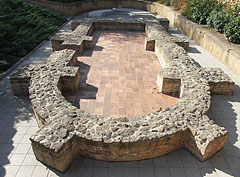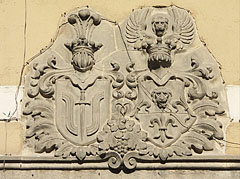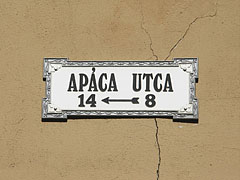(Оптимизирована для устройств с небольшим экраном)
Downtown, miscellaneous pictures - Pécs (Печ), Венгрия
При нажатии:
Нажмите на изображении!
-

The Barbican (or "Barbakán" in Hungarian) bastion on the castle wall, and the Episcopal Palace
Дата фотографии: 20092009
Создано: Роберт Немет
Модель камеры: Konica Minolta Dimage A200
Pécs (Печ), Венгрия
-

"Pezsgőház" or "Champagne House", the building of the former Littke champagne factory
Дата фотографии: 20092009
Создано: Роберт Немет
Модель камеры: Konica Minolta Dimage A200
Pécs (Печ), Венгрия
-

Wall remains of the chapel, viewed from its apse, over the Early Christian Burial Chamber I (Peter-Paul chamber or crypt)
This chamber was discovered in 1782.
Дата фотографии: 20092009
Создано: Роберт Немет
Модель камеры: Konica Minolta Dimage A200
Pécs (Печ), Венгрия
-

The ruins of turkish Memi Pasa's Baths, beside the Franciscan church
Дата фотографии: 20092009
Создано: Роберт Немет
Модель камеры: Konica Minolta Dimage A200
Pécs (Печ), Венгрия
-

Facade of the Roman Catholic Priory Church of Our Lady, with a Virgin Mary Statue above the door
Created by Mihály Bartalits in 1850
Дата фотографии: 20092009
Создано: Роберт Немет
Модель камеры: Konica Minolta Dimage A200
Pécs (Печ), Венгрия
-

The door of the Priory Church or Convent Church of Our Lady ("Miasszonyunk-zárdatemlom")
Formerly the baroque style Roman Catholic Church of Our Lady ("Nagyboldogasszony-templom") stood on this place, that was built in 1727.
Дата фотографии: 20092009
Создано: Роберт Немет
Модель камеры: Konica Minolta Dimage A200
Pécs (Печ), Венгрия
-

Apáca Street
Дата фотографии: 20092009
Создано: Роберт Немет
Модель камеры: Konica Minolta Dimage A200
Pécs (Печ), Венгрия
-

Carved limestone crests over the door of the County Library
Дата фотографии: 20092009
Создано: Роберт Немет
Модель камеры: Konica Minolta Dimage A200
Pécs (Печ), Венгрия
-

The door of the County Library was built in the late 18th century, above there are some carved crests
There are 4th-century Roman tombs in its courtyard.
Дата фотографии: 20092009
Создано: Роберт Немет
Модель камеры: Konica Minolta Dimage A200
Pécs (Печ), Венгрия
-

Street sign on a wall
Дата фотографии: 20092009
Создано: Роберт Немет
Модель камеры: Konica Minolta Dimage A200
Pécs (Печ), Венгрия
-
A building of the Hungarian State Treasury in Pécs
Дата фотографии: 20092009
Создано: Роберт Немет
Модель камеры: Konica Minolta Dimage A200
Pécs (Печ), Венгрия
A building of the Hungarian State Treasury in Pécs - Pécs (Печ), Венгрия -
A building of the Hungarian State Treasury in Pécs
Дата фотографии: 20092009
Создано: Роберт Немет
Модель камеры: Konica Minolta Dimage A200
Pécs (Печ), Венгрия
A building of the Hungarian State Treasury in Pécs - Pécs (Печ), Венгрия -
Дата фотографии: 20092009
Создано: Роберт Немет
Модель камеры: Konica Minolta Dimage A200
Pécs (Печ), Венгрия
- Pécs (Печ), Венгрия -
The romantic style Priory Church of Our Lady
The current church was built between 1852 and 1854.
Дата фотографии: 20092009
Создано: Роберт Немет
Модель камеры: Konica Minolta Dimage A200
Pécs (Печ), Венгрия
The romantic style Priory Church of Our Lady - Pécs (Печ), Венгрия -
Дата фотографии: 20092009
Создано: Роберт Немет
Модель камеры: Konica Minolta Dimage A200
Pécs (Печ), Венгрия
- Pécs (Печ), Венгрия -
Дата фотографии: 20092009
Создано: Роберт Немет
Модель камеры: Konica Minolta Dimage A200
Pécs (Печ), Венгрия
- Pécs (Печ), Венгрия -
Дата фотографии: 20092009
Создано: Роберт Немет
Модель камеры: Konica Minolta Dimage A200
Pécs (Печ), Венгрия
- Pécs (Печ), Венгрия -
Дата фотографии: 20092009
Создано: Роберт Немет
Модель камеры: Konica Minolta Dimage A200
Pécs (Печ), Венгрия
- Pécs (Печ), Венгрия -
Дата фотографии: 20092009
Создано: Роберт Немет
Модель камеры: Konica Minolta Dimage A200
Pécs (Печ), Венгрия
- Pécs (Печ), Венгрия -
Дата фотографии: 20092009
Создано: Роберт Немет
Модель камеры: Konica Minolta Dimage A200
Pécs (Печ), Венгрия
- Pécs (Печ), Венгрия -
Дата фотографии: 20092009
Создано: Роберт Немет
Модель камеры: Konica Minolta Dimage A200
Pécs (Печ), Венгрия
- Pécs (Печ), Венгрия -
Дата фотографии: 20092009
Создано: Роберт Немет
Модель камеры: Konica Minolta Dimage A200
Pécs (Печ), Венгрия
- Pécs (Печ), Венгрия -
Дата фотографии: 20092009
Создано: Роберт Немет
Модель камеры: Konica Minolta Dimage A200
Pécs (Печ), Венгрия
- Pécs (Печ), Венгрия -
"Pezsgőház" or "Champagne House", the building of the former Littke champagne factory
Дата фотографии: 20092009
Создано: Роберт Немет
Модель камеры: Konica Minolta Dimage A200
Pécs (Печ), Венгрия
"Pezsgőház" or "Champagne House", the building of the former Littke champagne factory - Pécs (Печ), Венгрия -
Дата фотографии: 20092009
Создано: Роберт Немет
Модель камеры: Konica Minolta Dimage A200
Pécs (Печ), Венгрия
- Pécs (Печ), Венгрия -
Statue of Tivadar Csontváry Kosztka Hungarian painter, in front of the Csontváry Museum
The statue was created by Jenő Kerényi in 1962.
Дата фотографии: 20092009
Создано: Роберт Немет
Модель камеры: Konica Minolta Dimage A200
Pécs (Печ), Венгрия
Statue of Tivadar Csontváry Kosztka Hungarian painter, in front of the Csontváry Museum - Pécs (Печ), Венгрия -
Дата фотографии: 20092009
Создано: Роберт Немет
Модель камеры: Konica Minolta Dimage A200
Pécs (Печ), Венгрия
- Pécs (Печ), Венгрия -
Дата фотографии: 20092009
Создано: Роберт Немет
Модель камеры: Konica Minolta Dimage A200
Pécs (Печ), Венгрия
- Pécs (Печ), Венгрия -
Дата фотографии: 20092009
Создано: Роберт Немет
Модель камеры: Konica Minolta Dimage A200
Pécs (Печ), Венгрия
- Pécs (Печ), Венгрия -
Дата фотографии: 20092009
Создано: Роберт Немет
Модель камеры: Konica Minolta Dimage A200
Pécs (Печ), Венгрия
- Pécs (Печ), Венгрия -
Дата фотографии: 20092009
Создано: Роберт Немет
Модель камеры: Konica Minolta Dimage A200
Pécs (Печ), Венгрия
- Pécs (Печ), Венгрия -
Дата фотографии: 20092009
Создано: Роберт Немет
Модель камеры: Konica Minolta Dimage A200
Pécs (Печ), Венгрия
- Pécs (Печ), Венгрия -
Дата фотографии: 20092009
Создано: Роберт Немет
Модель камеры: Konica Minolta Dimage A200
Pécs (Печ), Венгрия
- Pécs (Печ), Венгрия -
Love padlocks on the wall
Дата фотографии: 20092009
Создано: Роберт Немет
Модель камеры: Konica Minolta Dimage A200
Pécs (Печ), Венгрия
Love padlocks on the wall - Pécs (Печ), Венгрия -
Love locks (lovers' padlocks)
Дата фотографии: 20092009
Создано: Роберт Немет
Модель камеры: Konica Minolta Dimage A200
Pécs (Печ), Венгрия
Love locks (lovers' padlocks) - Pécs (Печ), Венгрия -
A corner house
Дата фотографии: 20092009
Создано: Роберт Немет
Модель камеры: Konica Minolta Dimage A200
Pécs (Печ), Венгрия
A corner house - Pécs (Печ), Венгрия -
Love padlocks
Дата фотографии: 20092009
Создано: Роберт Немет
Модель камеры: Konica Minolta Dimage A200
Pécs (Печ), Венгрия
Love padlocks - Pécs (Печ), Венгрия -
Love padlocks on the so-called "Lovers' Wall, the second"
Дата фотографии: 20092009
Создано: Роберт Немет
Модель камеры: Konica Minolta Dimage A200
Pécs (Печ), Венгрия
Love padlocks on the so-called "Lovers' Wall, the second" - Pécs (Печ), Венгрия -
Lovers' padlocks
Дата фотографии: 20092009
Создано: Роберт Немет
Модель камеры: Konica Minolta Dimage A200
Pécs (Печ), Венгрия
Lovers' padlocks - Pécs (Печ), Венгрия -
Janus Pannonius Street, the "Lovers' Wall" with the padlocks can be shown on the left
Дата фотографии: 20092009
Создано: Роберт Немет
Модель камеры: Konica Minolta Dimage A200
Pécs (Печ), Венгрия
Janus Pannonius Street, the "Lovers' Wall" with the padlocks can be shown on the left - Pécs (Печ), Венгрия -
Barbican ("Barbakán" bastion or tower)
Дата фотографии: 20092009
Создано: Роберт Немет
Модель камеры: Konica Minolta Dimage A200
Pécs (Печ), Венгрия
Barbican ("Barbakán" bastion or tower) - Pécs (Печ), Венгрия -
The gate of the Barbican with the drawbridge
Дата фотографии: 20092009
Создано: Роберт Немет
Модель камеры: Konica Minolta Dimage A200
Pécs (Печ), Венгрия
The gate of the Barbican with the drawbridge - Pécs (Печ), Венгрия -
Glimpse to the Bishop's Palace from the Barbican
Дата фотографии: 20092009
Создано: Роберт Немет
Модель камеры: Konica Minolta Dimage A200
Pécs (Печ), Венгрия
Glimpse to the Bishop's Palace from the Barbican - Pécs (Печ), Венгрия -
Barbican ("Barbakán")
Дата фотографии: 20092009
Создано: Роберт Немет
Модель камеры: Konica Minolta Dimage A200
Pécs (Печ), Венгрия
Barbican ("Barbakán") - Pécs (Печ), Венгрия -
Barbican ("Barbakán")
Дата фотографии: 20092009
Создано: Роберт Немет
Модель камеры: Konica Minolta Dimage A200
Pécs (Печ), Венгрия
Barbican ("Barbakán") - Pécs (Печ), Венгрия -
A creeper plant (Parthenocissus) covered stone gate, with the Barbakán bastion (the Barbican)
Дата фотографии: 20092009
Создано: Роберт Немет
Модель камеры: Konica Minolta Dimage A200
Pécs (Печ), Венгрия
A creeper plant (Parthenocissus) covered stone gate, with the Barbakán bastion (the Barbican) - Pécs (Печ), Венгрия -
Remains of the former castle wall near the Bishop's Palace
Дата фотографии: 20092009
Создано: Роберт Немет
Модель камеры: Konica Minolta Dimage A200
Pécs (Печ), Венгрия
Remains of the former castle wall near the Bishop's Palace - Pécs (Печ), Венгрия -
Bronze statue of Janus Pannoniues, the 15th-century Hungarian humanist poet and bishop of Pécs
Created by Miklós Borsos in 1972
Дата фотографии: 20092009
Создано: Роберт Немет
Модель камеры: Konica Minolta Dimage A200
Pécs (Печ), Венгрия
Bronze statue of Janus Pannoniues, the 15th-century Hungarian humanist poet and bishop of Pécs - Pécs (Печ), Венгрия -
Statue of Janus Pannonius Hungarian humanist poet, in front of the Barbican and the Episcopal Palace
The statue was created by Borsos Miklós in 1972.
Дата фотографии: 20092009
Создано: Роберт Немет
Модель камеры: Konica Minolta Dimage A200
Pécs (Печ), Венгрия
Statue of Janus Pannonius Hungarian humanist poet, in front of the Barbican and the Episcopal Palace - Pécs (Печ), Венгрия -
The yellow Bishop's Palace (or Episcopal Palace, in Hungarian: "Püspöki Palota") from the garden
Дата фотографии: 20092009
Создано: Роберт Немет
Модель камеры: Konica Minolta Dimage A200
Pécs (Печ), Венгрия
The yellow Bishop's Palace (or Episcopal Palace, in Hungarian: "Püspöki Palota") from the garden - Pécs (Печ), Венгрия -
Tower of the Bishop's Palace (or Episcopal Palace in other words)
Дата фотографии: 20092009
Создано: Роберт Немет
Модель камеры: Konica Minolta Dimage A200
Pécs (Печ), Венгрия
Tower of the Bishop's Palace (or Episcopal Palace in other words) - Pécs (Печ), Венгрия -
The Bishop's Palace and the castle wall
Дата фотографии: 20092009
Создано: Роберт Немет
Модель камеры: Konica Minolta Dimage A200
Pécs (Печ), Венгрия
The Bishop's Palace and the castle wall - Pécs (Печ), Венгрия -
The metal sculpture of Ferenc Liszt Hungarian composer looks around from the balcony
The stainless chromium steel statue was created by Imre Varga in 1983.
Дата фотографии: 20092009
Создано: Роберт Немет
Модель камеры: Konica Minolta Dimage A200
Pécs (Печ), Венгрия
The metal sculpture of Ferenc Liszt Hungarian composer looks around from the balcony - Pécs (Печ), Венгрия -
Tower of the Episcopal Palace (or Bishop's Palace)
Дата фотографии: 20092009
Создано: Роберт Немет
Модель камеры: Konica Minolta Dimage A200
Pécs (Печ), Венгрия
Tower of the Episcopal Palace (or Bishop's Palace) - Pécs (Печ), Венгрия -
Calstle wall remains and the Bishop's Palace
Дата фотографии: 20092009
Создано: Роберт Немет
Модель камеры: Konica Minolta Dimage A200
Pécs (Печ), Венгрия
Calstle wall remains and the Bishop's Palace - Pécs (Печ), Венгрия -
Barbican ("Barbakán" bastion or tower)
Дата фотографии: 20092009
Создано: Роберт Немет
Модель камеры: Konica Minolta Dimage A200
Pécs (Печ), Венгрия
Barbican ("Barbakán" bastion or tower) - Pécs (Печ), Венгрия -
Дата фотографии: 20092009
Создано: Роберт Немет
Модель камеры: Konica Minolta Dimage A200
Pécs (Печ), Венгрия
- Pécs (Печ), Венгрия -
Loophole or porthole on the Barbican, shaped like a cross-bearing orb (globus cruciger)
Дата фотографии: 20092009
Создано: Роберт Немет
Модель камеры: Konica Minolta Dimage A200
Pécs (Печ), Венгрия
Loophole or porthole on the Barbican, shaped like a cross-bearing orb (globus cruciger) - Pécs (Печ), Венгрия -
The circular-shaped Barbican ("Barbakán") bastion with a small drawbridge and the flag of Hungary
Дата фотографии: 20092009
Создано: Роберт Немет
Модель камеры: Konica Minolta Dimage A200
Pécs (Печ), Венгрия
The circular-shaped Barbican ("Barbakán") bastion with a small drawbridge and the flag of Hungary - Pécs (Печ), Венгрия -
The TV tower of Pécs and the Mecsek Mountains from the inner city
The tower was inaugurated in 1973.
Дата фотографии: 20092009
Создано: Роберт Немет
Модель камеры: Konica Minolta Dimage A200
Pécs (Печ), Венгрия
The TV tower of Pécs and the Mecsek Mountains from the inner city - Pécs (Печ), Венгрия -
The TV tower of Pécs, on the top of the Misina Mountain in the Mecsek Mountain Range
The tower is 197 meters tall, as well as the mountain where it stands is 535 meters above the ocean level.
Дата фотографии: 20092009
Создано: Роберт Немет
Модель камеры: Konica Minolta Dimage A200
Pécs (Печ), Венгрия
The TV tower of Pécs, on the top of the Misina Mountain in the Mecsek Mountain Range - Pécs (Печ), Венгрия -
The romantic style synagogue of Pécs
It was built in 1869, architects: Frigyes Feszl, Károly Gerster and Lipót Kauser.
Дата фотографии: 20092009
Создано: Роберт Немет
Модель камеры: Konica Minolta Dimage A200
Pécs (Печ), Венгрия
The romantic style synagogue of Pécs - Pécs (Печ), Венгрия -
The steeple (tower) of the Franciscan church
Дата фотографии: 20092009
Создано: Роберт Немет
Модель камеры: Konica Minolta Dimage A200
Pécs (Печ), Венгрия
The steeple (tower) of the Franciscan church - Pécs (Печ), Венгрия -
The Memi Pasa's Turkish Bath from the Ottoman period
It was discovered in 1979.
Дата фотографии: 20092009
Создано: Роберт Немет
Модель камеры: Konica Minolta Dimage A200
Pécs (Печ), Венгрия
The Memi Pasa's Turkish Bath from the Ottoman period - Pécs (Печ), Венгрия -
The Franciscan Church of Pécs (officially called Parish Church of St. Francis of Assisi)
It was built between 1718 and 1760.
Дата фотографии: 20092009
Создано: Роберт Немет
Модель камеры: Konica Minolta Dimage A200
Pécs (Печ), Венгрия
The Franciscan Church of Pécs (officially called Parish Church of St. Francis of Assisi) - Pécs (Печ), Венгрия -
Memi Pasa's Baths from the time of the Ottoman (turkish) rule in Hungary
Дата фотографии: 20092009
Создано: Роберт Немет
Модель камеры: Konica Minolta Dimage A200
Pécs (Печ), Венгрия
Memi Pasa's Baths from the time of the Ottoman (turkish) rule in Hungary - Pécs (Печ), Венгрия -
The Franciscan Church of Pécs (Parish Church of St. Francis of Assisi or simply the Friars' church)
Дата фотографии: 20092009
Создано: Роберт Немет
Модель камеры: Konica Minolta Dimage A200
Pécs (Печ), Венгрия
The Franciscan Church of Pécs (Parish Church of St. Francis of Assisi or simply the Friars' church) - Pécs (Печ), Венгрия -
Wall painting on theFranciscan church
Дата фотографии: 20092009
Создано: Роберт Немет
Модель камеры: Konica Minolta Dimage A200
Pécs (Печ), Венгрия
Wall painting on theFranciscan church - Pécs (Печ), Венгрия -
A fresco on the outer wall of the Franciscan church
Painted by Ernő Gebauer in 1926
Дата фотографии: 20092009
Создано: Роберт Немет
Модель камеры: Konica Minolta Dimage A200
Pécs (Печ), Венгрия
A fresco on the outer wall of the Franciscan church - Pécs (Печ), Венгрия -
Tower and steeple of the Franciscan Church of Pécs (the Friars' church)
Дата фотографии: 20092009
Создано: Роберт Немет
Модель камеры: Konica Minolta Dimage A200
Pécs (Печ), Венгрия
Tower and steeple of the Franciscan Church of Pécs (the Friars' church) - Pécs (Печ), Венгрия
Нажмите на изображении!
Характеристики, особенности
Расположение:
GPS координаты: Широта 46°4'40", Долгота 18°13'17" (N46 4.67 - E18 13.28)
Информация, короткие рассказы, интересности
 "Pezsgőház" or "Champagne House", the building of the former Littke champagne factory
"Pezsgőház" or "Champagne House", the building of the former Littke champagne factory
The Littke Champagne Factory was founded by the Polish-born Lőrinc Littke in 1859, it was the first champagne production facility within the territory of the present-day Hungary. The first champagne factory in the area of the historical Hungary (Kingdom of Hungary, until 1920) was opened in Pozsony (today Bratislava, Slovakia) in 1825, founded by János Fischer wine and colonial produce merchant and dr. Mihály Schönbauer physician, then in 1877 it was acquired by the Austrian-born Johann E. Hubert. The Hungarian word for champagne is "pezsgő", it means bubbly or sparkling and probably created by Count István Széchenyi, who mentioned it first in his writing called "Hitel" ("Credit") in 1830. Formerly the French "champagnier" or "champagne" words were used for the sparkling wine in Hungary.
The headquarters of Lőrinc Littke's factory was in Pécs, in the so-called "Pezsgőház" (literally "Champagne House") building on the Szent István Square. The Littke Champagne Factory was operating until the end of World War II, then in 1949 the state monopolized it and the production of champagne in Pécs was virtually ceased for some time. The champagne production was restarted in the Littke Winery only in 1966, under Pannonvin Champagne Factory name an as a part of the "Állami Pincegazdaság" (approx. "State Winery"). After more change in the name and the owner the former Littke Winery is now operated by a company which engages in both viticulture and winery.
 "Pezsgőház" or "Champagne House", the building of the former Littke champagne factory
"Pezsgőház" or "Champagne House", the building of the former Littke champagne factory
For 90 years the "Pezsgőház" ("Champagne House") in Pécs was the home of one of the first champagne production facility in Hungary, the Littke Champagne Factory. Below it there is one of the longest cellar systems of Pécs. It is 2 km long and has five levels beneath the building, the lowest is 12 meters under the street level. The cellars have an average temperature of between 12 and 14 °C and they can be visited. There is a champagne museum here, as well as a 200-hectoliter-capacity giant oak barrel and of course many other curiosities. The building on the Szent István Square is today already more than 150 years old, among others there is a restaurant (Pezsgőház Restaurant) within its walls, since 1999.
 Bronze statue of Janus Pannoniues, the 15th-century Hungarian humanist poet and bishop of Pécs
Bronze statue of Janus Pannoniues, the 15th-century Hungarian humanist poet and bishop of Pécs
Created by Miklós Borsos in 1972
Janus Pannonius (born as János Csezmiczei, 1434-1472) was the bishop of Pécs and the first Hungarian humanist poet who was known also by his name throughout Europe. He was born in a Croato-Hungarian probably as Croatian under the name of Ivan Česmički, in Chezmicze (present-day Čazma), Croatia. He lived in the age of King Matthias Corvinus, in the 15th-century renaissance Hungary. He studied in Nagyvárad (in Romanian Oradea, today in Romania) and his uncle Archbishop János Vitéz was his mentor. By the way, János Vitéz was the initiator of the Hungarian humanism, and also one of the educators of Matthias Hunyadi, the later King Matthias I of Hungary.
In its time the poetry of Janus Pannonius was a novelty, because instead of the religious ideas now it put the emphasis on the humanism and the renaissance attitude to life (desire for peace, life-loving, admiration of the nature, appreciation of science and culture, etc.). The style of his poems is based on the Italian humanism.
There is a full-figure statue of the poet in the garden of the Bishop's Palace ("Püspöki palota") in Pécs. It was created by Miklós Borsos, who entrusted the face of the poet to his imagination, because there's no any survived authentic portrait of Janus Pannonius. Allegedly this is why the statue wears a wide-brimmed Italian hat, to overshadow the face and also refer to its mysteriousness. The bronze artwork was inaugurated in 1972 for the 500th anniversary of the poet's death. In addition, an almond tree was planted beside the statue to refer his love of nature and also to one of his nice verse.
Pécs (Печ) - Другие галереи фото:
Вы также можете быть заинтересованы в (Связанные страницы):
Места назначения в путеводителе:
Pécs (Печ) (225 фотографии + 3 панорамные снимки)
Mecsek Mountains (304 фотографии + 3 панорамные снимки)
Баранья медье (857 фотографии + 4 панорамные снимки)
Южно-Задунайский край (Dél-Dunántúl) (1 597 фотографии + 8 панорамные снимки)
Венгрия (27 287 фотографии + 163 панорамные снимки)
и кроме того:
(в здесь: Mecsek Mountains)
Abaliget (10 фотографии)
Magyaregregy (69 фотографии)
Orfű
Püspökszentlászló
Каждая панорама фото здесь:
Pécs (Печ) (3 фотографии)
Баранья медье (4 фотографии)
Южно-Задунайский край (Dél-Dunántúl) (8 фотографии)
Венгрия (163 фотографии)
Европа (165 фотографии)
Все нормальные фотографии здесь:
Pécs (Печ) (225 фотографии / 4 галереи)
Mecsek Mountains (304 фотографии / 6 галереи)
Баранья медье (857 фотографии / 17 галереи)
Южно-Задунайский край (Dél-Dunántúl) (1 597 фотографии / 32 галереи)
Венгрия (27 287 фотографии / 462 галереи)
Европа (30 494 фотографии / 523 галереи)
https://www.panadea.com/ru/guidebook/pecs/photos/gal-004

Добавить в Избранное Добавь в Закладки
Поделитесь с вашими друзьями!
и т.д.
Наш путеводитель содержит:
Многочисленные фотографии и панорамные изображения, с большим количеством информации и интересных фактов.
- 214 места назначения
- 165 панорамные снимки
- 30 494 другие фотографии
Большая коллекция отобранных фотографий: превосходное качество, высокое разрешение и естественные цвета
О нас - Юридическая декларация -
Все права защищены
- ©2010-2022
Neuronit Creative Studio - Mogyoród / Будапешт / Венгрия





